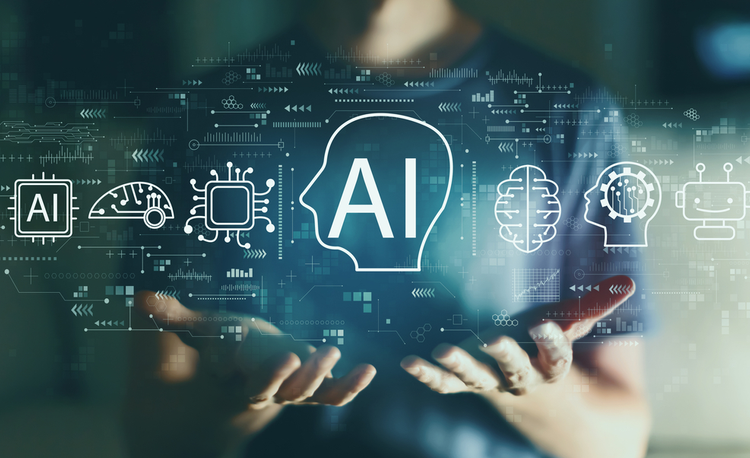Teaching content creation with artificial intelligence
AI-powered content creation taps into the creative side of all of us, allowing us to come up with great blog topics and write great content. While the creative side can be fun, the scientific side is much more complicated. Additionally, content creation is a huge process requiring much time, effort, and input. Now, wouldn’t it be great if there was a way you could still enjoy the fun part of it and not get tired of producing content every day?
In fact, thanks to AI content creators, this is possible. Using AI alongside your regular content creation efforts can help increase your output without compromising your delivery quality. In the following, we will examine all aspects of content production with artificial intelligence.

What is creative content production with artificial intelligence?
Basically, AI-powered content creation means that the software creates the content for you. It can write posts for an online store or social media site, e-books, landing pages, emails, product listings, anything. It is even possible to produce audio and video content.
The tools discussed offer different skills. Some can mass-produce blog posts with the click of a button, while others are great at choosing email subject lines that have the most impact on opens.
How does content production work with the help of artificial intelligence?
AI content generation tools do not generate content out of nowhere. They need notifications, and that’s where the human element comes in. People can enter descriptions, ideas for tone of voice, and any key elements they want before the AI tool generates the content (which often happens within seconds).
These tools work using natural language processing (NLP) and natural language generation (NLG) models that learn the genetic structure of human language to create versions that appear to be written by a real person.
When using AI, you can enter a query, such as a few keywords, a short description of your business or topic for the tool to work with, and any other relevant information. AI then uses this information and other data it has access to to create content that is exactly what you want.
The more you use this tool, the more knowledge the AI will gain and the more accurate it will be each time. Especially if you tell it what you think and don’t like about its creations.
In addition to writing content for you, AI content tools can also give you ideas on what to write about and how to write it. This is especially helpful if you’re struggling to come up with content ideas or don’t know what to write next.
Once the AI tools come up with topic ideas, the tools can provide suggested layouts and related information so you can make sure you’ve included everything. The tools do this through NLP strategies, where they crawl through billions of other articles on a topic and reveal areas that are covered and gaps that are missing.
This will help you consistently create more comprehensive content than your competitors and ensure you’re providing all the information your audience needs, building trust and credibility.
Will artificial intelligence take over human content production?
A question that may have troubled your mind, in short, the answer is negative. Bots are unlikely to replace humans in any inherently creative endeavor, and content creation is creative work, especially if you strip away the scientific, metrics-focused aspect of it.
So, while AI tools may become more common, they are simply a way to enhance content creation and ensure that marketers and brands publish content of the highest quality possible. When you’re new to AI content creation, there’s a good chance the content will require a human touch, whether it’s through editing or formatting. You may need to optimize the content depending on your platform. Even as the AI tool masters your wants and needs, you’ll likely still have to tweak the content occasionally to make it look how you want it to.
What kind of content does AI technology work best for?
There are different types of content generated by artificial intelligence. AI technology is more adept at generating written content such as blog posts, e-books, product listings, emails, topics, article headlines, and more.
However, with the increasing popularity of artificial intelligence tools, there has been a move towards creating and automating video and audio. There’s a good chance we’ll see more AI tools emerge that focus solely on this type of content. But now, the written content created by artificial intelligence tools is very high quality.
Using ChatGPT to generate creative content
ChatGPT is an artificial intelligence chatbot developed by Open AI. The chatbot has a language-based model that the developer adjusts for conversational human interaction. It’s effectively a simulated chatbot designed primarily for customer service. However, people use it for various other purposes as well.
ChatGPT works by collecting data from the internet written by people and using computational predictions to answer questions and queries entered by the user. The responses it generates are generated by text and information requests, from which the chatbot learns more about various topics and how to discuss them.
But that is changing. OpenAI has officially announced that ChatGPT will be upgraded. The AI company will put the GPT-4 infrastructure into the AI bot, allowing you to interact with ChatGPT using text and images.
The main feature of ChatGPT is to generate responses that humans provide in a text box. Therefore, it is suitable for chatbots, artificial intelligence system conversations, and virtual assistants.
However, it can also give natural answers to questions in a conversational tone and generate poems, stories, and more. In addition, it can also:
- Coding
- Write an article or blog post
- Translation
- Debugging
Writing stories and poems
For the AI to fulfill one of these requests, you must type the command into the chatbot.
Introducing 15 content creation tools with artificial intelligence
1. Jasper
One of the content creation tools with artificial intelligence is Jasper. Jasper is an all-in-one AI content creation tool. You can quickly produce high-quality content with a collection of templates that can help you create everything from email subject lines, property listings, product descriptions, headlines, and long blog posts to video scripts and personalized bios. You can also create custom images with Jasper’s AI art generator. The Boss Mode feature of this artificial intelligence helps you create content 5 times faster.
2. HubSpot
HubSpot’s content strategy tool uses artificial intelligence and deep learning technology to discover original content ideas and topics that are likely to perform well among your audience and in the SERPs. It does this by scanning millions of posts on similar topics before suggesting topic clusters that help you rank and stand out from the competition. Before he suggests anything, he does competitive research to ensure the topics he suggests are worthwhile and clears up any guesses and doubts you might have.
3. Phrases
Once you find a content topic or keyword, it can be difficult to know where to start. For content creators, staring at a blank page is never fun. Phrase works by using machine learning to create general summaries based on similar content across the web. In addition to compiling an outline using actual questions that searchers have asked, it suggests keywords and subheadings that you can use throughout your content to ensure your content ranks well.
4. Grammarly
One of the tools for editing and proofreading content with artificial intelligence is Grammarly, which is often used for English texts. Writing is often the essence of content creation, but your content must be readable and engaging. Grammarly uses AI technology to suggest better phrases, check your grammar, and basically make sure your content is engaging and accessible to the right people.
5. Synthesia
While most content AI tools focus on text content, Synthesia is one of the first to focus solely on video content creation. It’s common knowledge that creating a video can be time-consuming, but it can pay off tenfold because it’s one of the most engaging forms of content. Synthesia works by using artificial intelligence to create an avatar-based video or audio to match a script you’ve already written.
With this tool, you can enhance your videos with music, images, and text overlays to make them more attractive.

6. MarketMuse
One of the hardest parts of content creation is coming up with the right ideas. Content marketing involves a lot of moving parts, and to be successful, you need to create the right content at the right time. MarketMuse uses artificial intelligence and machine learning technology to reveal search terms to target as well as topic categories to focus on.
This gives you a great SEO-focused starting point that you can use to create comprehensive and relevant content.
7. Deep Dream
It uses a deep learning algorithm to generate unique, abstract images based on user inputs.
8. Adobe Sensei
It includes a wide range of features for creating and editing images and videos, including object detection, scene analysis, and automatic background removal.
9. Pebblely
One of the ways to produce content with artificial intelligence is this tool. This tool uses artificial intelligence to transform product images into multiple marketing assets. This is a great way to overcome the hurdle of investing in product photography and helps adapt your product images to different social channels for easy distribution.
10.Lumen5
This tool can use artificial intelligence to analyze a specific text and generate a corresponding video with accompanying images and music.
11. DALL-E
One of the most popular image-generation tools is DALL-E, which uses artificial intelligence to generate images based on text input.
12. Canva
The tool includes an integration that allows you to enter a string of text to get a unique image for your marketing.
13. Language Translation
Some examples of AI tools that can help with translation include DeepL, which uses machine translation to translate texts from one language to another accurately, and Google Translate, which can translate text and speech into different languages.
14. Audio description
Another way to produce content with artificial intelligence is this tool. Artificial intelligence can be used to create audio descriptions of visual content, such as videos and images, for people who are blind or have low vision. VEED uses artificial intelligence to generate audio descriptions of visual content automatically.

15. Captioning
With this tool, you can automatically create subtitles for audio and video content using artificial intelligence to make them more accessible to deaf or hard-of-hearing people. The AI tool Automatic Synchronization Technologies (AST) uses machine learning to generate subtitles for audio and video content automatically.
What are the advantages of creating content with artificial intelligence?
There are many reasons to create AI-style content. For example, it can be a great companion in your content creation process. This is the best way to maximize your efforts and ensure you create content that resonates with your target audience and ranks well in search engines.
The various tools available help you in various aspects of content creation, from ideation to choosing keywords and writing content from scratch. Of course, a human element is still needed,, and you have to edit and change each piece yourself. But it can dramatically increase and speed up your process.













